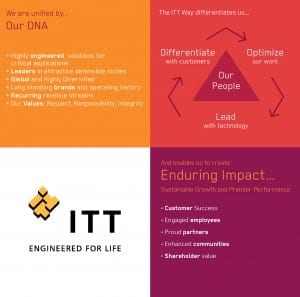Changing an organization’s culture is a daunting task. It requires comprehensive planning, both internal and external research and outreach and integration with all departments.
“The topic of ‘culture’ is a big animal,” says Leila Siman, director, employee engagement communication at ITT Corp. “First you must recognize that a culture already exists, what the culture is and if you are satisfied with it. If not, what will you do about it?”
So how does a company that aspires to be a Zappos (customer service), an Apple (innovation) or a Patagonia (environmental) achieve those types of winning cultures? And how can communicators help to enhance the process?
Let’s be clear: a culture change isn’t a pure PR play, Siman says. “Culture starts at the top, but it has to be reinforced every day through leadership across the organization, and supported by clear goals and objectives,” she says.
Michael McDougall, managing partner at PR agency McDougall Travers Collins, thinks of PR’s role in a culture change as serving as a business partner with the senior leadership team and other stakeholders. That’s not to say PR takes a backseat in the partnership. “PR’s role in setting expectations as to what’s to come and telling the stories of wins along the way is essential,” McDougall says. “Only in doing so can the organization gain understanding and buy-in from essential influencers and employees at large.”
The process is slow by design, and patience is paramount. “Cultural shifts do not happen overnight. In fact, the harder you sometimes push, the slower the pace of change.” McDougall’s patience concept might be put into play at Yahoo right now.
TOO MUCH, TOO SOON?
After the Silicon Valley icon burned through four CEOs in five years, Marissa Mayer jumped the Google ship in July 2012 and took the helm at Yahoo. For the most part, it’s been pretty smooth sailing, given that the company has been in disarray for the last several years. First, Mayer issued employees company smartphones for better productivity, then she became one of the few Fortune 500 CEOs to have a baby during her tenure. Plus, a series of inspiring memos to employees rallied the troops.
With the media fawning over Mayer and the changes she engineered there was bound to be a hiccup. It came last week, when Mayer announced that Yahoo will require all employees to work from a Yahoo office. All of a sudden, for many workers around the world—particularly women with children—Mayer had lost her culture-changing touch.
Perhaps in her haste to accelerate a “productive” culture at Yahoo, Mayer slowed the pace of change, like McDougall says. We’ll see.
SOCIAL CONNECTION
Much like Yahoo, SAS has a very visible CEO. The difference is that Jim Goodnight has been setting the tone at the software company for 30 years. Because of that, Becky Graebe, the company’s internal communications manager, hasn’t had to really define the corporate culture.
“I really feel like ‘it is what it is,’” Graebe says. It’s hard to capture in words, but what Goodnight has created is an open and transparent environment, one in which it’s OK to make mistakes, as long as you learn from them. Perhaps that’s why SAS is often at the top of “Best Places to Work” lists annually.

Launched in 2011 after the ITT Corp. spun off two of its businesses, The ITT Way culture-change initiative embeds messages throughout the company—from the C-suite to the rank and file.Executive leadership, internal communications and HR are the main keepers of culture at SAS. It’s about everyone staying connected, Graebe says. And with a global presence, social networking is at the top of the list as a key culture-maintainence tool.
“We’ve got to make sure that as we plan globally, we must stay connected,” says Graebe. The launch of new internal social platform in 2011 enabled much of this connection. Among 13,000 employees worldwide, 10,000 are using the platform.
The big corporate culture challenge at SAS: educating managers who are not quite sure what an “open” culture is, Graebe adds. It’s up to the communications team to demonstrate the values of respect and sharing ideas.
Here’s three tips from Graebe on getting cultural messages across an organization:
• Let employees tell the story: Everyone owns a piece of the corporate culture. Even if you have a common set of core values, those values are going to play out differently among various roles and functions. Intentionally seek ways through employee Q&A or video interviews to learn what that means on individual and team levels.
• Give them space to work together and learn from one another: “For SAS, this happens in virtual spaces such as our social networking platform,” Graebe says. Employees post photos of activities, request feedback on ideas and projects, promote new resources and offerings and form groups with similar interests.
• Trust them and have some fun: Take your work seriously, but don’t take yourselves too seriously. Celebrate what is important to you. “Our employees who can rally internally around the quirkiness of Pi Day (March 14) will apply that same one-for-all, all-for-one energy around a company-wide social media blitz for a new product launch,” Graebe says.
Meanwhile, at ITT, Siman and her team—along with strategy execution agency Gagen MacDonald —have been working to spread the messages of “The ITT Way,” developed when the company spun off its defense and water businesses in 2011. What was left was a $2 billion global manufacturing company focused on the energy, transportation and industrial markets.
Thanks to an internal-first approach, leadership now extols the message points of The ITT Way in just about everything they do, she says.
Challenges? Buy-in has been the easy part. But it’s tough to reach employees around the globe who may not have access to communications tools.
It just takes time, Siman says. Working is easy. Change is hard. PRN
CONTACT:
Leila Siman, [email protected]; Michael McDougall, [email protected]; Becky Graebe, [email protected].
